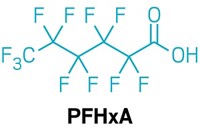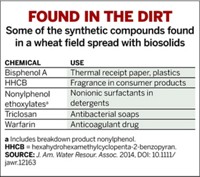Advertisement
Grab your lab coat. Let's get started
Welcome!
Welcome!
Create an account below to get 6 C&EN articles per month, receive newsletters and more - all free.
It seems this is your first time logging in online. Please enter the following information to continue.
As an ACS member you automatically get access to this site. All we need is few more details to create your reading experience.
Not you? Sign in with a different account.
Not you? Sign in with a different account.
ERROR 1
ERROR 1
ERROR 2
ERROR 2
ERROR 2
ERROR 2
ERROR 2
Password and Confirm password must match.
If you have an ACS member number, please enter it here so we can link this account to your membership. (optional)
ERROR 2
ACS values your privacy. By submitting your information, you are gaining access to C&EN and subscribing to our weekly newsletter. We use the information you provide to make your reading experience better, and we will never sell your data to third party members.
Persistent Pollutants
PFAS levels higher in fertilizers made from urban waste
New variants of PFAS urgently need more study, researchers say
by Alla Katsnelson, special to C&EN
October 23, 2021
| A version of this story appeared in
Volume 99, Issue 39
Fertilizers made from urban sewage and compost and from industrial waste contain higher levels of per- and polyfluoroalkyl substances (PFAS) than those made from livestock manure, according to a new study (Environ. Sci. Technol. 2021, DOI: 10.1021/acs.est.1c03697). Sewage sludge and other urban waste reflect what’s consumed in the home, underscoring the continued presence of these compounds, says Sébastien Sauvé, an environmental chemist at the University of Montreal who led the investigation. By comparing samples collected decades ago with those collected recently, Sauvé and coworkers found that although the presence of some key PFAS compounds has declined over time, closely related chemicals are popping up. “The standard compounds that we wanted to ban and reduce consumption of are going down, but new ones are appearing,” Sauvé says. The researchers analyzed 47 solid waste samples for 160 PFAS compounds. The samples were collected in France during two periods: 1976–98 and 2009–17. Agricultural waste samples contained low levels of PFAS, but urban waste levels were over 300 times as high. More recent samples were especially rich in compounds called fluorotelomers (example shown), new compounds made to replace older, banned PFAS. Fluorotelomers may degrade a bit more readily but are still persistent, Sauvé says, and some degrade into the problematic older PFAS. Although researchers suspect that many fluorotelomers are toxic, few have been studied. “What we know for sure is that we don’t know enough,” Sauvé says.






Join the conversation
Contact the reporter
Submit a Letter to the Editor for publication
Engage with us on Twitter